Ever since Virat Kohli took over the reins from MS Dhoni in Test cricket, one thing he and Ravi Shastri, before, and Anil Kumble, now have been insistent on is playing five bowlers to enable the team to have a better chance of taking 20 wickets in order to win a Test Match.
This has been employed since the Sri Lanka tour last year, and was continued in the South Africa series at home. On both occasions, India came out as winners quite convincingly, just as they have done in the ongoing West Indies tour where they lead 2-0 in a four match series with one more Test still to be played. In the tours to Sri Lanka and now in the West Indies, India have opted to go with three quicks and two spinners, whereas, during the series at home against South Africa, in conditions that favoured spin more predominantly, India went in with three spinners and two fast bowlers.
From what we have witnessed thus far, it is fair to say that India’s five-bowler strategy has worked out to a relatively successful degree and more often than not has yielded desired results for the team, both home and away.
Kohli’s Selflessness

Virat Kohli was asked about the various changes he had made for the third Test and his general approach when it comes to making changes quite often.
He said, “Usually if you see very few people like change. This team doesn’t think how others would react or what they might say. We put out a combination that’s best according to the pitch. When I came at number three, many people asked why I did it. But I am not fixated by my batting spot. If the team needs, I can open the batting too because that’s the rule applicable to everyone in the team. It’s not as if I will stay at number four and others will shuffle their positions.
“To field a player like Rohit Sharma we had to make him bat at number five. To make that happen, the other players will go one place up the order. That’s what we did. In bowling we replaced Umesh [Yadav] with Bhuvi [Bhuvneshwar Kumar] because we felt that since the ground is so good it would be easier to maintain the shine on the ball.
“The pitch was also hard, so there was carry. Bhuvi gave us the results, gave us breakthroughs with the second new ball. Our idea was that we have to seal the series here. We made three changes and we understood Rohit needs to be backed at a particular position. I batted at number three, Jinks [Ajinkya Rahane] at number four. Rohit is dangerous at number five. That means I take up the extra responsibility at number three. I don’t mind that and someone like Ashwin is batting well, and we can play five bowlers.”
The basic combination for India is 5+1+5: five batsmen, a wicketkeeper in Wriddhiman Saha – who is improving with the bat with every passing game and also scored his maiden Test century last week – and five bowlers. The five batsmen are expected to take extra responsibility and there are five players jostling for three positions, with Kohli and Rahane expected to be certainties in the team.
Batting Line-Up
KL Rahul, Murali Vijay, Shikhar Dhawan, Cheteshwar Pujara and Rohit Sharma are fighting to be in the three spots available to them. With Ashwin’s promotion to number six paying dividends so far, having scored two hundreds already in the ongoing series, it looks like Virat Kohli’s plan seems to be working well. The wicketkeeper, Saha, is expected to slot in at seven followed by four bowlers. The competition for limited batting slots means that India’s batting is well stocked with more than capable reserve batsmen in the waiting, too.

India’s first choice spinner is undoubtedly Ravichandran Ashwin, and there is a toss-up between Amit Mishra and Ravindra Jadeja who tend to offer some variety and guile to the bowling attack.
The seamers who generally seem to be in contention for a place in the first XI are Mohammad Shami, Ishant Sharma, Umesh Yadav, Bhuvneshwar Kumar and Varun Aaron. This constant chopping and changing at the moment seems to be working, in both the batting and bowling departments.
Does Change Pay Off?
There are two ways you could look at this and draw to a conclusion.
One, this way a proper team balance can be worked out by giving several opportunities to different players and by doing this, one can clearly find out what works perfectly for the team. However, there could be repercussions because of this. By constantly changing the line ups as well as the position each one bats, this would mean no one would feel settled and there’s also a possibility that they feel insecure about their positions. This could mean there might be some tentativeness amongst the players and might not allow them to play aggressively and without pressure, just the way Virat Kohli, as he has often stated, would like to see his team play the game.
So, there are two ways this whole conundrum could be solved, and either way, there are pros and cons. At the moment, the current approach seems to be working relatively fine but it is to be seen if this success can be maintained in the long term, by employing this method.





